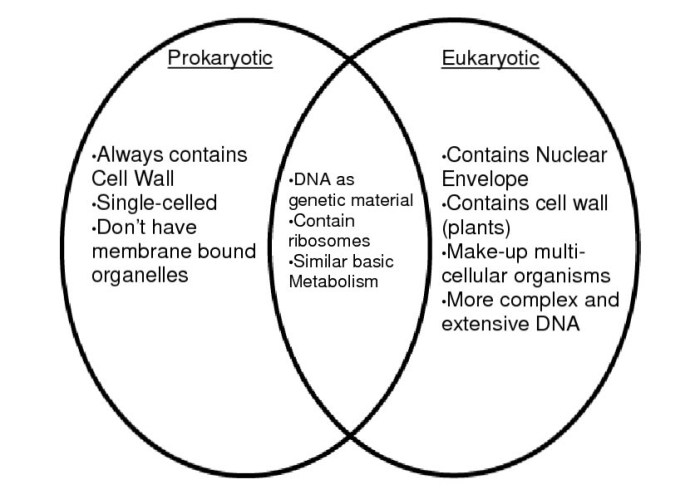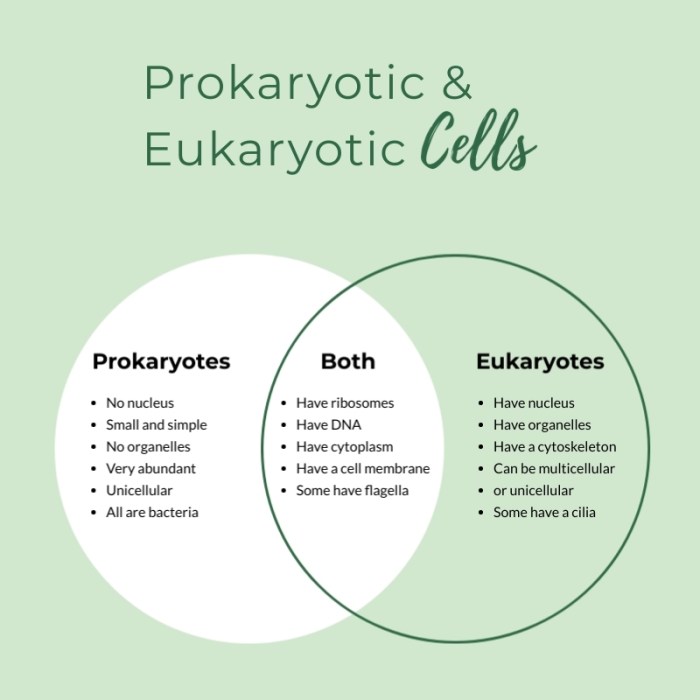Create a Venn diagram comparing prokaryotic and eukaryotic cells to unveil the intriguing distinctions and shared characteristics that define these two fundamental cell types. Embark on a journey of cellular exploration as we delve into the unique attributes of each cell type, revealing the complexities that underpin the diversity of life.
Prokaryotic and eukaryotic cells represent the two primary categories of cells, each possessing distinct structural and functional features. Understanding their differences is crucial for comprehending the fundamental principles of biology and the evolution of life on Earth.
Overview of Prokaryotic and Eukaryotic Cells

Cells are the fundamental units of life, and they can be broadly classified into two main types: prokaryotic and eukaryotic cells. Prokaryotic cells are simpler in structure and lack a nucleus, while eukaryotic cells are more complex and have a nucleus.
This article provides a comprehensive overview of the key characteristics, differences, and similarities between prokaryotic and eukaryotic cells.
Venn Diagram Structure
To visualize the shared and unique characteristics of prokaryotic and eukaryotic cells, a Venn diagram is employed. The diagram consists of two overlapping circles, with one representing prokaryotic cells and the other representing eukaryotic cells. The overlapping area represents the shared characteristics, while the non-overlapping areas represent the unique characteristics of each cell type.
Shared Characteristics
Despite their differences, prokaryotic and eukaryotic cells share several fundamental characteristics. These include:
- Cell membrane: A selectively permeable barrier that surrounds the cell and regulates the movement of substances into and out of the cell.
- Cytoplasm: A gel-like substance that fills the cell and contains the cell’s organelles.
- Ribosomes: Small structures responsible for protein synthesis.
- DNA: The genetic material that carries the instructions for cell growth and function.
Unique Characteristics of Prokaryotic Cells
Prokaryotic cells are characterized by their lack of a nucleus and membrane-bound organelles. They have a simple cellular structure and are typically smaller than eukaryotic cells. Other unique characteristics of prokaryotic cells include:
- Circular DNA: The DNA of prokaryotic cells is typically arranged in a single, circular chromosome.
- No membrane-bound organelles: Prokaryotic cells do not have membrane-bound organelles such as mitochondria, chloroplasts, or endoplasmic reticulum.
- Examples: Bacteria and archaea are examples of prokaryotic organisms.
Unique Characteristics of Eukaryotic Cells
Eukaryotic cells are more complex than prokaryotic cells and have a nucleus and membrane-bound organelles. They are typically larger than prokaryotic cells and have a more organized cellular structure. Other unique characteristics of eukaryotic cells include:
- Linear DNA: The DNA of eukaryotic cells is typically arranged in multiple, linear chromosomes.
- Membrane-bound organelles: Eukaryotic cells have membrane-bound organelles such as mitochondria, chloroplasts, and endoplasmic reticulum.
- Examples: Plants, animals, fungi, and protists are examples of eukaryotic organisms.
Overlapping Characteristics, Create a venn diagram comparing prokaryotic and eukaryotic cells
The overlapping area in the Venn diagram represents the shared characteristics of prokaryotic and eukaryotic cells. These characteristics are essential for cell function and include:
- Cell membrane: The cell membrane is responsible for maintaining the cell’s integrity and regulating the movement of substances into and out of the cell.
- Cytoplasm: The cytoplasm contains the cell’s organelles and is the site of many cellular processes.
- Ribosomes: Ribosomes are essential for protein synthesis and are found in all living cells.
- DNA: DNA is the genetic material that carries the instructions for cell growth and function.
Common Queries: Create A Venn Diagram Comparing Prokaryotic And Eukaryotic Cells
What is the main difference between prokaryotic and eukaryotic cells?
The primary difference lies in the presence of a nucleus and membrane-bound organelles. Eukaryotic cells possess a nucleus and membrane-bound organelles, while prokaryotic cells lack these features.
Which type of cell is larger, prokaryotic or eukaryotic?
Eukaryotic cells are generally larger than prokaryotic cells.
What are some examples of prokaryotic organisms?
Bacteria and archaea are examples of prokaryotic organisms.
What are some examples of eukaryotic organisms?
Plants, animals, fungi, and protists are examples of eukaryotic organisms.

